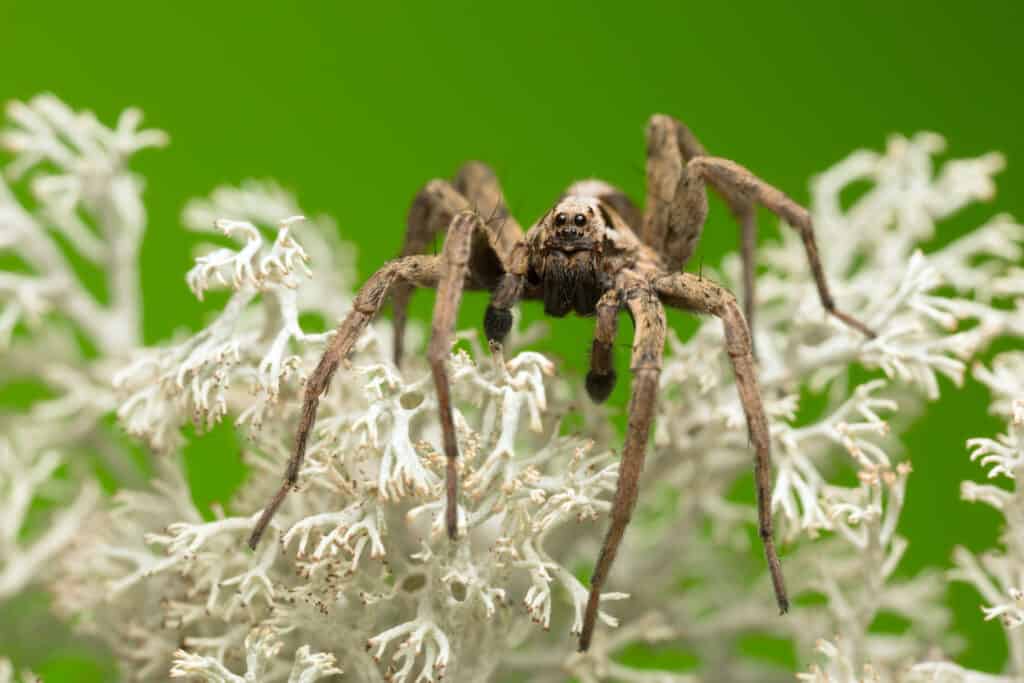Almost all spiders are venomous, but there are few, at least in North America, that have venom powerful enough to injure a human. One of them is the brown recluse spider, whose venom can be fatal. Ironically, the fangs of this spider are so small that they can’t really bite through clothing. The bite of the wolf spider can cause pain and swelling but isn’t life-threatening. So, the wolf spider and brown recluse are quite different.
People bitten by a brown recluse should seek emergency medical attention, as the bites can cause necrotic skin lesions and lead to serious reactions, especially in children. After treatment by a doctor, they heal nicely, with the use of ice, rest, compression, and elevation. A brown recluse bite is not as life-threatening as a Black Widow bite, but you should definitely seek treatment immediately.
Wolf spiders belong to the Lycosidae family. Lykos is Greek for “wolf.” Besides 2888 species, there are 124 genera. The brown recluse belongs to the Loxosceles genus, and Loxosceles is Greek for “slanting legs.” There are 11 species of Loxosceles spiders found in the United States. There are also other differences between the wolf spider and the brown recluse. Let’s take a look at some of them.
Comparing Wolf Spider vs Brown Recluse
Here is a table of facts that shows some of the differences between a wolf spider and a brown recluse spider.
| Traits | Wolf Spider | Brown Recluse |
|---|---|---|
| Size | 0.04 to 1.5 inches | 0.24 to 0.79 inches |
| Venom | Not dangerous | Potentially dangerous |
| Habitat | Woods, forests, meadows, etc. | Human habitation |
| Behavior | Can be aggressive | Shy, reclusive |
| Species | 2888 | One |
| Range | Worldwide | Midwestern to Southern U.S. |
| Web | No | Yes |
| Colors | Gray, brown, black, buff | Brown |
Five Cool Facts About Wolf Spider vs Brown Recluse
Wolf spiders and brown recluse spiders are two of the most common spiders found in North America. While both species can be intimidating to encounter, they have some interesting differences.
Here are five cool facts about wolf spiders and brown recluse spiders:
- Appearance: Wolf spiders are large, hairy spiders that are typically brown, gray, or black in color. They have prominent eyes that shine in the dark and are often mistaken for wolf eyes, hence their name. Brown recluse spiders, on the other hand, are smaller and have distinct violin-shaped markings on their brown body.
- Hunting: Wolf spiders are active hunters that rely on their excellent eyesight to track and catch their prey. They do not spin webs but instead, chase down their prey on foot. Brown recluse spiders, on the other hand, are passive hunters that build small webs to capture their prey.
- Venom: While both species are venomous, brown recluse spiders are considered to be more dangerous to humans due to the potency of their venom. The venom of a brown recluse spider can cause tissue damage and may even lead to necrosis in some cases. In contrast, the venom of a wolf spider is generally not harmful to humans.
- Habitat: Wolf spiders can be found in a wide range of habitats, including forests, grasslands, and suburban areas. They often live in burrows or other protected areas. Brown recluse spiders are more commonly found in dry, warm areas such as attics, basements, and closets.
- Reproduction: Wolf spiders carry their eggs in a sac attached to their abdomen and will fiercely protect their young. Brown recluse spiders, on the other hand, build small webs to protect their egg sacs, which contain dozens of eggs.
In conclusion, while wolf spiders and brown recluse spiders may look similar to the untrained eye, they have distinct differences in their appearance, hunting behavior, venom, habitat, and reproduction.
The Five Key Differences Between Wolf Spider vs Brown Recluse
1. Body Type

The brown recluse spider is often identified by the violin-shaped marking on its body.
©Nick626/Shutterstock.com
One way of identification of the brown recluse spider is to count its eyes. It can be easily told from the wolf spider, indeed, from most other spiders, in that it has six eyes. Most other spiders have eight.
The presence of eyes that are about the same size and come in pairs arranged on its head means the arachnid is most likely a brown recluse. Wolf spiders have a pair of huge eyes in the middle of their faces with four others below it in a line and two more above it. These eyes give the spider superb vision. The vision of the brown recluse is probably not very good.
The brown recluse also holds its long legs crabwise, while the wolf spider splays its legs out like most other spiders. With close to 3000 species, wolf spiders come in many sizes and color patterns. The colors are usually earth-toned, for the spider is part of the diet of many larger animals and needs to stay camouflaged as it searches for prey.
The brown recluse is light brown and often has a violin-shaped mark on its cephalothorax. This gives it the alternate name of fiddle back or violin spider. Brown recluse spiders are usually between 0.24 to 0.79 inches long, while the length of a wolf spider ranges from between 0.04 to 1.5 inches.
2. Habitat
Wolf spiders are found all over the world save the coldest places. Their habitats include forests, woods, coastal areas, mountains, human habitations, meadows, and gardens. They don’t spin webs but some dig burrows or create turrets that they protect with pebbles or trap doors. Brown recluse spiders are found in the United States from Nebraska down to Texas and east to Georgia and Kentucky. They spin messy webs in secret places such as garages, closets, basements, and sheds. They seem especially fond of living beneath cardboard. People get bitten when they reach a hand into some dark corner and frighten the spider.
3. Reproduction
Both wolf spiders and brown recluse spiders have courtship rituals, and the rituals of some wolf spider species can be elaborate. Wolf spiders are unique among spiders in that the females carry their egg cases in their spinnerets. When the eggs hatch, the babies climb on her back and hang on as she moves from place to place. Eventually, they disperse by releasing a strand of silk and letting it form a type of parachute that takes them away in the wind. Brown recluse spiders also produce an egg sac, and the mother sometimes carries it or hangs it on her web or on a plant. When the spiderlings hatch they stay in the egg sac until their first molt. Unlike wolf spiders, they don’t ride their mother’s back or travel from place to place via ballooning.
4. Behavior

Male wolf spider, Alopecosa inquilina on lichen
©Henrik Larsson/Shutterstock.com
Brown recluse spiders are shy and retiring, and they spend the day in a quiet place and come out at night to hunt. Like most other spiders, their diet largely consists of insects, including those that are household pests such as cockroaches. Wolf spiders can be aggressive even toward humans, and one species is so aggressive that its name is Rabidosa rabida. While some wolf spiders sit and wait for potential prey to come within striking distance, others stalk and then pounce on them like wolves. Some hunt during the day, while others rest during the day and hunt at night like the brown recluse.
5. Toxicity
Both brown recluse and wolf spiders have venom that can affect humans. The neurotoxins in wolf spider venom are considered mild and hardly ever cause a reaction more pronounced than some localized pain and swelling in humans. Brown recluse spiders have extremely potent venom that can cause a variety of different reactions in humans, producing symptoms ranging from painful ulcers at the wound site to months-long tissue necrosis.
Brown recluse bites almost never result in death, though secondary complications like infection are also a concern. Most severe reactions to brown recluse venom occur in children, the elderly, and those with compromised immune systems. Wolf spiders aren’t deadly, so unless you have an allergy to the venom, a wolf spider bite should heal on its own in a few days with little to no complications.
Bonus: What Keeps Spiders Away?

Spiders find certain essential oil scents repugnant like peppermint oil.
©Tatevosian Yana/Shutterstock.com
One of a person’s worst nightmares is having spiders wind up in their home–especially the poisonous kind! The best way to avoid getting bitten by a spider is to try and prevent them from entering your house in the first place. As spiders can get into your home through holes and cracks, you can check for possible entryways with a flashlight. If the light gets through from the inside to the outside, you should fill that hole or crevice with an appropriate product.
Keeping your yard free of debris and overgrown vegetation helps cut down on areas spiders would gravitate to. Caulking doors and windows is also a good strategy to keep them out.
Spiders hate certain scents, so scented essential oils can help deter them like peppermint, tea-tree, lavender, and rose. You can add 15-20 drops of a particular oil in a water bottle mixed with water and spritz it around your house. They also hate the smell of cinnamon and vinegar, so these scents can be used similarly.
Regular cleaning inside your home, especially in areas that are dark or less frequented, is necessary to keep spiders from setting up residence. It’s also important to keep an eye on fruit bowls, as they can attract spiders.
The photo featured at the top of this post is ©
FAQs (Frequently Asked Questions)
What spiders can be mistaken for a brown recluse?
One spider that’s often mistaken for a brown recluse is the huntsman spider, which holds its legs crabwise like the recluse. However, some facts about these spiders are that have eight eyes and can grow larger than the brown recluse, and like the brown recluse, they like to hide in dark and quiet places. Armed with potent venom, the bite of these poisonous spiders may need medical attention.
Do brown recluse spiders kill wolf spiders?
Wolf spiders are generally not part of the brown recluse’s diet. Wolf spiders are often bigger than brown recluse spiders, and though spiders have been known to eat each other, be they conspecifics or members of other species, these two spiders appear to steer clear of each other.
How do I identify a wolf spider?
Identification of a wolf spider can be easy if you can get close enough to it. They are often of neutral colors such as brown or gray, and some have stripes. Many are large for spiders. But the surest way to identify a wolf spider is to notice the huge anterior median eyes in its face. Jumping spiders also have these big eyes, but they are much smaller, and their legs tend to be shorter.
Thank you for reading! Have some feedback for us? Contact the AZ Animals editorial team.






